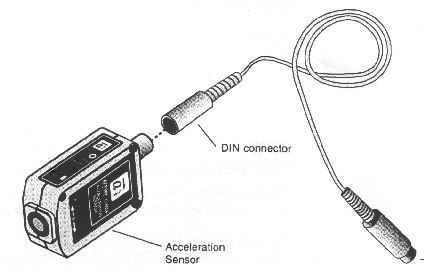
The PASCO acceleration sensor is designed for use with any PASCO computer interface. It can measure accelerations ranging up to 5g with an accuracy of 0.01g (g = acceleration of gravity, 9.8 m/s2). The sensor produces a bipolar output that may vary from +5g to -5g, depending on the direction of acceleration. Each acceleration sensor has two built-in features for configuring it to a particular application:
The acceleration sensor is an electronic device, but a simple mechanical model illustrates its operation. Assume a ball is suspended in a box between two identical springs as shown in the figure below. One end of the box is marked with a + sign and the other with a - sign.

When the box is horizontal and at rest,
both springs have the same length. When the box is vertical and at rest, with the
+ end up, the spring connected to the + end is stretched and the spring
connected to the - end is
compressed. A sensor outputs a positive voltage proportional to the amount of
stretch of the spring connected to the + end. If the box is vertical, but
the - end is up, the sensor outputs a negative voltage proportional to the
amount of stretch of the spring connected to the negative end.
When the box is accelerating in a direction indicated by an arrow pointing
from - to +, the spring connected to the positive end will stretch and the
spring connected to the negative end will be compressed. The sensor
outputs a positive voltage, indicating positive acceleration. When the box
accelerates in the opposite direction, the sensor outputs a negative voltage,
indicating negative acceleration.